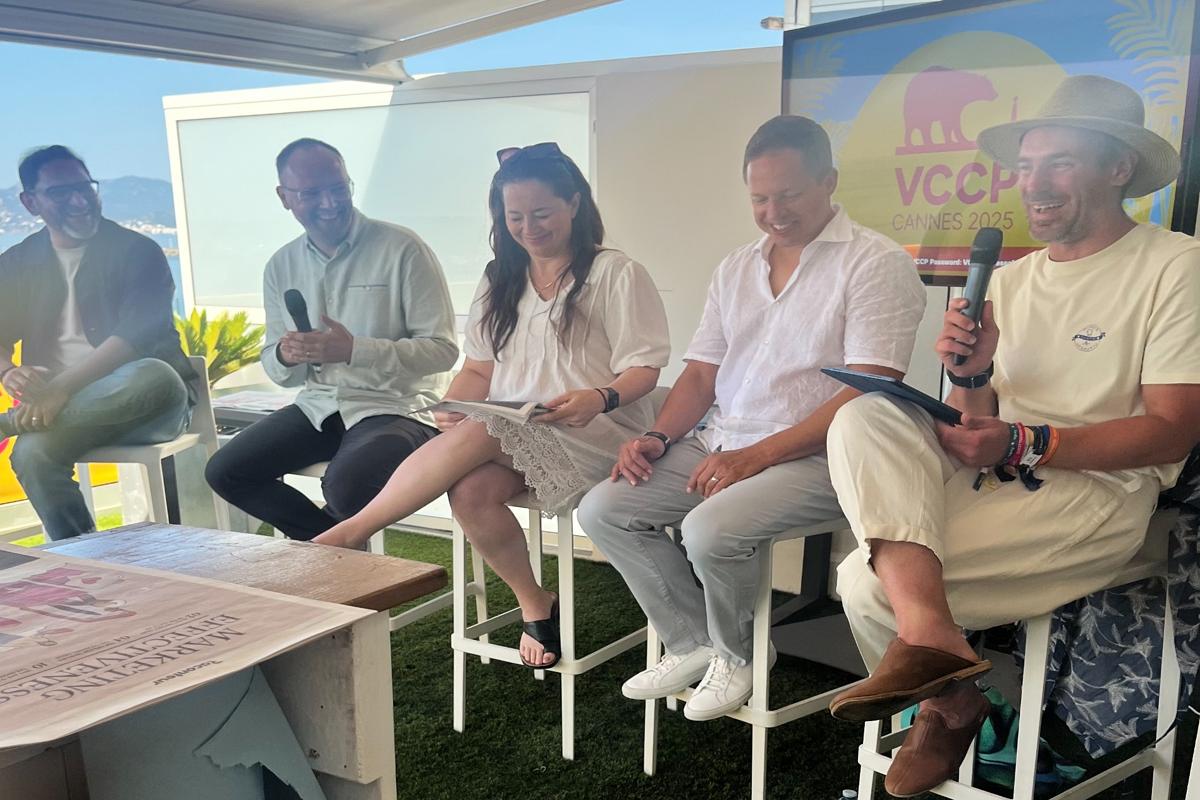
Marketing strategies defined by content overload are now the norm, yet most marketing output barely causes a ripple in the cultural pond. The attention economy is ruthless, and fleeting impressions are the best many brands can hope for. Yet amid this creative cacophony, a new framework is emerging – one that promises not just to capture attention but to build long-term brand equity. Enter ‘The Value Dividend’, a concept developed by Raconteur that positions content not as marketing ephemera but as a capital asset.
At this year’s Cannes Lions Festival, a panel of senior marketers and strategists unpacked the notion of unlocking long-term creative effectiveness, offering a rare behind-the-scenes look at what it takes to produce content that doesn’t just land, but lingers.
Joining Raconteur’s director of commercial content, Tom Watts, the session drew upon insights from Clare Hutchinson (chief strategy officer at VCCP), Neil Cameron (vice-president of marketing at Kevel), Joshua Gebhardt (CEO at Ampd), and Anudit Vikram (chief product officer at Channel Factory). The conversation revealed a shared belief: that strategic creativity, empowered by technology and underpinned by trust, is the secret to sustainable impact.
What makes great content actually great?
Great content isn’t defined by its production value or ad spend. Rather, it’s the product of three deceptively simple ingredients: insight, authenticity and identity.
“It starts with a strong consumer insight,” said Hutchinson. “Something simple and human that resonates. Most of the Cannes-winning work has that at its core.”
Hutchinson, who brings decades of brand planning experience, also emphasised authenticity: “Brands need to be true to who they are. That’s how you get consistency over time.” She highlighted the importance of “brand worlds” – a term that encapsulates the visual and emotional shorthand audiences instantly recognise. “Cadbury has its purple, O2 has its blue. But it’s more than colour. It’s a sense of place, mood and meaning.”
Channel Factory’s Vikram offered a complementary view, one focused on decoding the emotional signals beneath the surface: “We can now measure where the eye goes, how long attention lasts and what emotions are triggered. With AI, we extract the human signals that indicate real engagement,” he said. This data doesn’t replace human instinct – it augments it.
“Think of content as a mirror,” he continued. “Two people see the same ad but interpret it differently. Our role is to make sure what they see reflects what the brand intends, and what the user needs.”
Performance as proof
As brands push for both creativity and accountability, the question of long-term effectiveness looms large. What does success look like beyond the click?
For Gebhardt, it’s about marrying experimentation with speed. He recounted how a major beverage brand ran hundreds of creative variations on Meta platforms, using Ampd’s platform to pinpoint what truly resonated.
“It was binary: some creatives fell flat, others nearly went viral,” Gebhardt explained. “But the real win was speed. The brand could pivot in real time, boosting high-performers and cutting losses. That’s where brand trust starts to scale.”
However, this kind of rapid iteration isn’t without risk. Hutchinson raised a crucial concern: “How do we maintain creative quality while producing at scale?” She suggested the solution lies in a strong central idea. “If your insight is solid, and your strategy clear, then you can build creative variations that are still congruent.”
In other words, quantity doesn’t have to compromise quality – as long as the core remains untouched.
Distribution – the forgotten half of creativity?
Creating great content is one thing. Making sure it lands is another. As Kevel’s Cameron noted, “We were targeting everyone and no one. Once we got laser-focused on our audience, we saw real results.”
Kevel shifted from broad-stroke campaigns to highly personalised content strategies, mapping out the decision-making teams within their target companies. “It wasn’t just about getting the CEO’s attention,” Cameron explained. “It was about influencing everyone involved in the buying process.”
To that end, Kevel diversified its formats and placements: from industry podcasts to exclusive webinars, long-form explainers and customer-led storytelling. “Our customers can explain how they’ve used our tech better than we ever could,” said Cameron. “That authenticity goes further than any scripted narrative.”
Vikram elaborated on the back-end complexity of this targeting: “We use NLP, semantic analysis and predictive models to ensure that the right person sees the right content, at the right time. It’s not just about content creation; it’s about content alignment.”
He likened content to DNA: “We all look different on the surface, but under a microscope, there are shared structures. Likewise, we can deconstruct content to understand its emotional and contextual DNA, then match that to the audience.”
The new value exchange
Looking ahead, the panellists agreed that the balance of power between brands and audiences is shifting. Consumers are savvier, more sceptical and less patient. In this environment, what’s the right value exchange?
Vikram offered a three-part framework: “Respect the user, stay consistent as a brand and be transparent as a platform. That’s the triangle of trust.”
Cameron added, “Attention is something you earn now. Whether it’s a whitepaper or a TikTok, the audience needs a reason to give you their time.”
For Gebhardt, the key is agility: “You can’t wait a month for a lift study. Audiences move fast. Your insights and creative strategy need to move faster.”
And Hutchinson reminded the group not to lose sight of the human element: “We need to maintain space for creativity. Yes, AI can generate, but it can’t imagine. The spark still has to come from us.”
What this panel underscored is that creative effectiveness is no longer about going viral or chasing likes. It’s about building a brand in the long term – with precision, purpose and personality.
‘The Value Dividend’ is more than a catchy phrase. It reframes how marketers should approach content. Like financial dividends, content should pay back over time, not just once. To make an impact today marketers must consider the following factors, defined by our ‘IMPACT’ acronym:
- Insight: how their brand can combine original thinking with evidence and insights to create content that cuts through
- Message: how to better communicate the ideas that their audience cares about
- Presentation: what role design should play in helping content earn and hold the audience’s attention
- Accessibility: how to combine great content with best-in-class experiences (i.e. balancing value with data exchange)
- Context: the relevance and credibility of the environment they publish content in – and how to make use of high-authority, cross-channel opportunities to drive ROI?
- Targeting: how to combine content excellence with tactical targeting to reach the right people at the right time
Making an impact isn’t easy. It demands collaboration between strategists and creatives, data scientists and technologists, media planners and brand stewards. But those who embrace this complexity will do more than survive the attention economy – they’ll shape it.
As 2025 approaches, the content arms race will only intensify. But for brands willing to treat content not as filler but as a long-term asset, the dividends – in trust, loyalty and revenue – are theirs to reap.
Find out more about ‘The Value Dividend’ here.

Marketing strategies defined by content overload are now the norm, yet most marketing output barely causes a ripple in the cultural pond. The attention economy is ruthless, and fleeting impressions are the best many brands can hope for. Yet amid this creative cacophony, a new framework is emerging – one that promises not just to capture attention but to build long-term brand equity. Enter ‘The Value Dividend’, a concept developed by Raconteur that positions content not as marketing ephemera but as a capital asset.
At this year’s Cannes Lions Festival, a panel of senior marketers and strategists unpacked the notion of unlocking long-term creative effectiveness, offering a rare behind-the-scenes look at what it takes to produce content that doesn't just land, but lingers.
Joining Raconteur’s director of commercial content, Tom Watts, the session drew upon insights from Clare Hutchinson (chief strategy officer at VCCP), Neil Cameron (vice-president of marketing at Kevel), Joshua Gebhardt (CEO at Ampd), and Anudit Vikram (chief product officer at Channel Factory). The conversation revealed a shared belief: that strategic creativity, empowered by technology and underpinned by trust, is the secret to sustainable impact.





